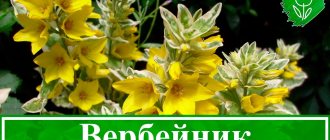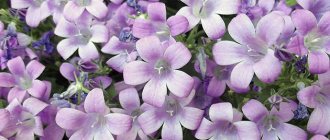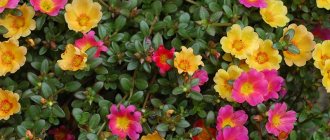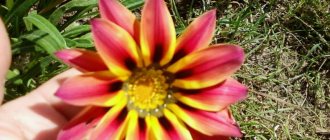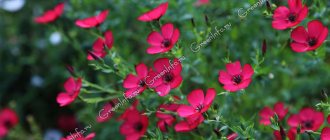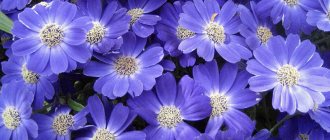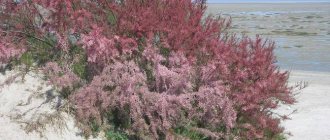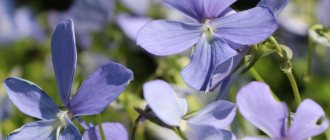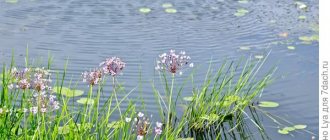Author: Elena N. https://floristics.info/ru/index.php?option=com_contact&view=contact&id=19 Category: Garden plants Published: February 26, 2019Last edits: January 13, 2021
- When to plant
- Rules of care
- How and when to collect seeds
- Gazania longiscapa
Gazania, or gazania, was brought to Europe from Mozambique. Today it is a popular garden crop everywhere. Gatsania crops produce almost one hundred percent germination, and flowering occurs quickly. One plant can have more than thirty inflorescences. Not only the golden baskets of gatsania are attractive, but also its bright green foliage, and some cultivars have downy stems and leaves, which gives them additional decorativeness.
From our article you will learn important details:
- about growing gatsaniya from seeds;
- about caring for the plant during the season;
- about how to collect seeds from a plant and how to preserve gatsaniya until spring.
Planting and caring for gatsaniya
- Planting: sowing seeds for seedlings in late March or early April with further planting of seedlings in open ground from mid-May to early June.
- Flowering: from June to November.
- Lighting: bright sunlight.
- Soil: light, nutritious, not waterlogged soil.
- Watering: moderate.
- Feeding: with a solution of complete mineral fertilizer once a month or one and a half, when growing on rocky soil - once every 2-4 weeks.
- Reproduction: seed.
- Pests: aphids, spider mites, snails and slugs.
- Diseases: gray rot.
Read more about growing gatsaniya below.
Gazania plant , or gazania , or African chamomile , belonging to the Asteraceae (Asteraceae) family, is represented by forty species that naturally grow in Mozambique and South Africa, as well as in the Australian coastal dunes. In the 17th century, the gazania flower appeared in Europe and received its current name in honor of the Italian priest Theodore von Gaza, famous for his translations of the works of Theophrastus and Aristotle. In Western Europe, this plant is called “midday gold” due to the fact that gatsania flowers, colored in warm shades, open at noon.
Favorable days for sowing gatsaniya in 2022 depending on the month
To enjoy the flowering of gazania throughout the summer, you need to choose more favorable days for planting seeds for growing seedlings.
- In February
– 3, 4, 12, 13, 14, 17, 18, 19, 20, 21, 22, 23 - In March
– 11, 12, 13, 16, 17, 19, 20, 21, 22, 23, 24, 29, 30, 31 - In April
– 8, 9, 13, 14, 15, 17, 18, 26, 27 - In May
– 5, 6, 7, 10, 11, 12, 13, 14, 15, 23, 24
For southern regions with early spring, it is possible to plant seeds for growing seedlings at the end of January. In this case, already in the month of May, the garden plot and flower beds will be decorated with bright, beautiful flowers.
Botanical description
The annual or perennial gatsaniya is low-growing, reaching a height of no more than 30 cm. The basal leaves are collected in a rosette, the stem is either short or absent at all. The leaves are dark green or grayish-green, dense, varied in shape, with thick silvery fibers on the underside of the plate, which serve the plant as protection from cold and retain moisture in the dry season. The inflorescences are single baskets with a diameter of 5 to 9 cm, consisting of reed flowers of orange, red, yellow with dark spots at the base, forming a ring pattern around a yellow center consisting of tubular flowers. There can be about thirty-five such inflorescences on one plant. The fruit is a hairy achene with a tuft.
- Planting carnation seedlings in open ground
Role in landscape design
Gatsania is often used for landscape design. It has become popular due to its yellow flowers, which are striking in contrast. There are crimson-white, yellow-orange, red, white and other shades of culture.
Ways to use it:
- for decorating paths;
- visual creation of a border between individual areas of the site;
- rockery decoration;
- growing in a flower bed;
- framing the edges of the flower bed.
Attention!
In order not to harm the gatsaniya and to decorate your site, you should not plant it next to tall plants that can create shade.
If this flower is planted correctly on the soil, you can make unusual patterns, circles, zigzags, and different shapes.
Growing gatsaniya from seeds
Sowing seedlings
Many lovers ask how to grow gatsania from seeds and when to sow gatsania for seedlings. The timing of sowing gatsaniya depends on the area in which you live. If your spring is late and cold, then planting gazania seedlings too early will require additional lighting for the growth of seedlings, because otherwise they will develop very slowly. On the other hand, if you sow the seeds late, for example in May, then the gatsaniya will bloom later.
Therefore, gatsania seeds are sown no earlier than mid-March, or even mid-April, in deep boxes so that the long tap root grows vertically, without bending. The soil in the boxes should be light, well-drained, pH 5.5-6.5.
You rarely need to sow, but it is better to simply arrange the seeds in a checkerboard pattern, keeping a distance of 2-3 cm between them. The seeds can be lightly sprinkled with soil on top, or you can simply press them tightly to the soil. Spray the seeds with a spray bottle, cover with film and place in a warm (18-20 ºC), bright place. It is necessary to ventilate and remove condensation daily. Shoots will appear in one to two weeks.
Growing seedlings
If the seedlings grow in a deep container, they do not need to be picked, but if the box is shallow, then after the fourth leaf appears on the seedlings, they are picked into peat pots and transferred for growing to a cooler room (12-16 ºC). An insulated but unheated loggia is suitable for this. At the same time, begin to accustom young plants to the temperature outside the window, opening the window briefly during the day, but so that the plants are not exposed to a draft.
In the photo: Growing gatsania in the garden
How to plant by cuttings
Gatsania can also be propagated by cuttings. By mid-summer, side shoots appear on the plant, which can be cut off with a sharpened knife or pruning shears. The cut parts of the plant are cleared of leaves and planted in soil previously fertilized with growth activators. In about 5-6 weeks, the gatsaniya will take root and be ready for replanting.
Cuttings are rarely used for propagation. This method is quite complex and requires some skills and abilities from the gardener. That is why seedlings are used more often.
Planting gatsaniya
When to plant
Planting seedlings in open ground is carried out from mid-May to early June, and in the future, caring for the gatsaniya flower will not be a punishment for you.
First you need to find a suitable site for the plant: an open sunny place with nutritious but light garden soil.
- Sowing gatsaniya, viola and begonia - at what depth should the seeds be planted?
Sunlight is vital for gatsaniya; even direct sunlight does not frighten it, since it is extremely light-loving and even drought-resistant.
In the photo: How gatsaniya blooms in open ground
How to plant
Gatsania seedlings are transplanted into open ground along with the pots in which the seedlings grew. If you grew your seedlings in a box, use a long scoop to remove each seedling with its root ball and transfer it to the hole without damaging the root system. The distance between gatsania bushes should be at least 20 cm. Gatsania from seeds blooms soon after transplanting into open ground, three months after sowing the seeds.
How to grow lobelia from seeds: sowing for seedlings and in the ground
Gatsaniya care
Rules of care
The conditions for growing gazania, as already mentioned, are bright sunlight and well-drained soil. But, despite its love for warmth, gatsaniya can also tolerate sudden cold snaps down to -5...-7 ºC. Caring for gatsaniya in the garden consists of moderate watering, followed by loosening the soil and removing weeds and timely removal of faded inflorescences so that the plant quickly forms new buds.
Mulching the soil is also encouraged, as it allows you to retain moisture in the soil longer in the summer heat and reduces the amount of weeds on the site.
Growing gatsaniya flowers also involves fertilizing with fertilizers: if your gatsaniya grows on fertile soil, you need to feed it once a month and a half with a solution of complete mineral fertilizer at the rate of 20-25 g per square meter, but if you planted it on rocky, poor soil, then You will have to fertilize once every 2-4 weeks.
In the photo: Growing gatsania in a flowerbed
Flowering plant
Gatsania blooms from June to November, and the flowering of each basket lasts about three weeks. In the dark and in cloudy weather, the reed flowers of gatsania curl up, covering the yellow center of the tubular flowers.
- How to pick petunia from a common container into separate cups
Sometimes gardeners complain that gatsaniya does not want to bloom. This may be due to insufficient lighting, excessive watering, or transplanting seedlings into open ground too late. Try not to violate the agrotechnical requirements of gatsaniya, and it will bloom on time and abundantly.
Pests and diseases
Anyone who has grown gatsaniya will tell you that it does not get sick. But if growing conditions are unfavorable for the plant, it weakens, and then it can be affected by gray rot. You will have to remove diseased specimens and treat the remaining plants with Fitosporin.
Among the insects that harm gatsania are snails, aphids and spider mites. Snails need to be collected by hand, and insects are destroyed with insecticides: aphids - Fitoverm, Akarin, Inta-vir, and spider mites - Actellik, Fufanon or Ditox.
In the photo: A combination of different varieties of gatsanias in a flowerbed
Gatsaniya after flowering
How and when to collect seeds
In our climatic conditions, gatsania seeds usually do not have time to ripen, unless the summer turns out to be hot, long and dry. In addition, mainly hybrid plant varieties are grown in culture, and their seeds do not retain species and varietal characteristics. And the most important obstacle for those who want to collect gatsania seeds is that, like dandelion seeds, when ripe, they simply fly away. Therefore, when gatsaniya begins to bloom, wrap several large flowers with gauze so that the seeds do not scatter, and secure it to the peduncle.
In the photo: Growing gatsania in a pot
Wintering of Gatsania
If you grow gatsaniya as an annual, simply destroy the remains of the plant after flowering. But you can try to save it for next year. To do this, the most beautiful still flowering bushes are dug up, transplanted into pots or boxes and stored in a well-lit room at a temperature of 8-10 ºC, watering them from time to time so that the soil does not dry out completely. In the spring, they are planted again in open ground, after shortening the shoots by half.
Planting and caring for gaillardia - advice from experienced gardeners
When to sow gazania for seedlings in 2022 according to the lunar calendar?
The further development and health of plants depends on the correct timing of planting seeds. Therefore, experienced gardeners and flower growers plan planting activities based on the lunar calendar.
It is necessary to exclude sowing work during the new moon or full moon. The days before and after the full moon and new moon are also considered unfavorable for planting work.
In February and March, it is best to plan work for the last days of the first ten days of the month and the first days of the third ten days of the month.
In April and May, planting events are carried out on the 8th, 9th, 13th, 14th, 15th, 17th, 18th, 26th, 27th and 5th, 6th, 7th, 10th, 11th, 12th, 13th, 14th, 15th, 23rd, 24th.
Types and varieties
Gazania longiscapa
An annual plant 15-20 cm high, the basal leaves are entire, slightly split, pubescent below, bright green above. The basket, up to 7 cm in diameter, consists of tubular and reed flowers of bright yellow color, with the bases of the reeds being colored brown.
In the photo: Gazania longiscapa
Gazania harsh or shiny (Gazania rigens, Gazania splendens)
Stems up to 30 cm tall, baskets from 4.5 to 6 cm in diameter. The tubular flowers are blood-black, the ligulate flowers are bright yellow, red or orange with black, brown or white spots at the base. The leaves are usually entire, but sometimes pinnately divided.
In the photo: Gazania harsh or shiny (Gazania rigens, Gazania splendens)
Gazania pottsii
An enlarged copy of gatsaniya harsh: the basket has a diameter of up to 12 cm.
Gazania pavonia
It differs from others in the shape of its leaves - narrow, long (up to 20 cm). A basket up to 8 cm in diameter with yellow-orange reed flowers with a black base and a yellow center of tubular flowers.
In the photo: Gazania pavonia
Also grown in cultivation are feathery gazania (Gazania pinnata), snow-white gazania (Gazania nivea), single-flowered gazania (Gazania unifiora) and hybrid gazania (Gazania x hybrida), obtained by crossing various species, but mainly long-lined and harsh gazania. Hybrid Gatsania varieties developed in recent years are capable of blooming even on cloudy days.
Of the most popular varieties of hybrid gatsania, it is worth mentioning:
- Daybreak Red Stripe - light yellow inflorescences with red stripes, opening in the morning and closing only at dusk;
- variety mixture Talent - a hit in 2001 with beautiful leaves and inflorescences that close only at night;
- Ministar variety group - varieties with yellow, white and orange baskets.
